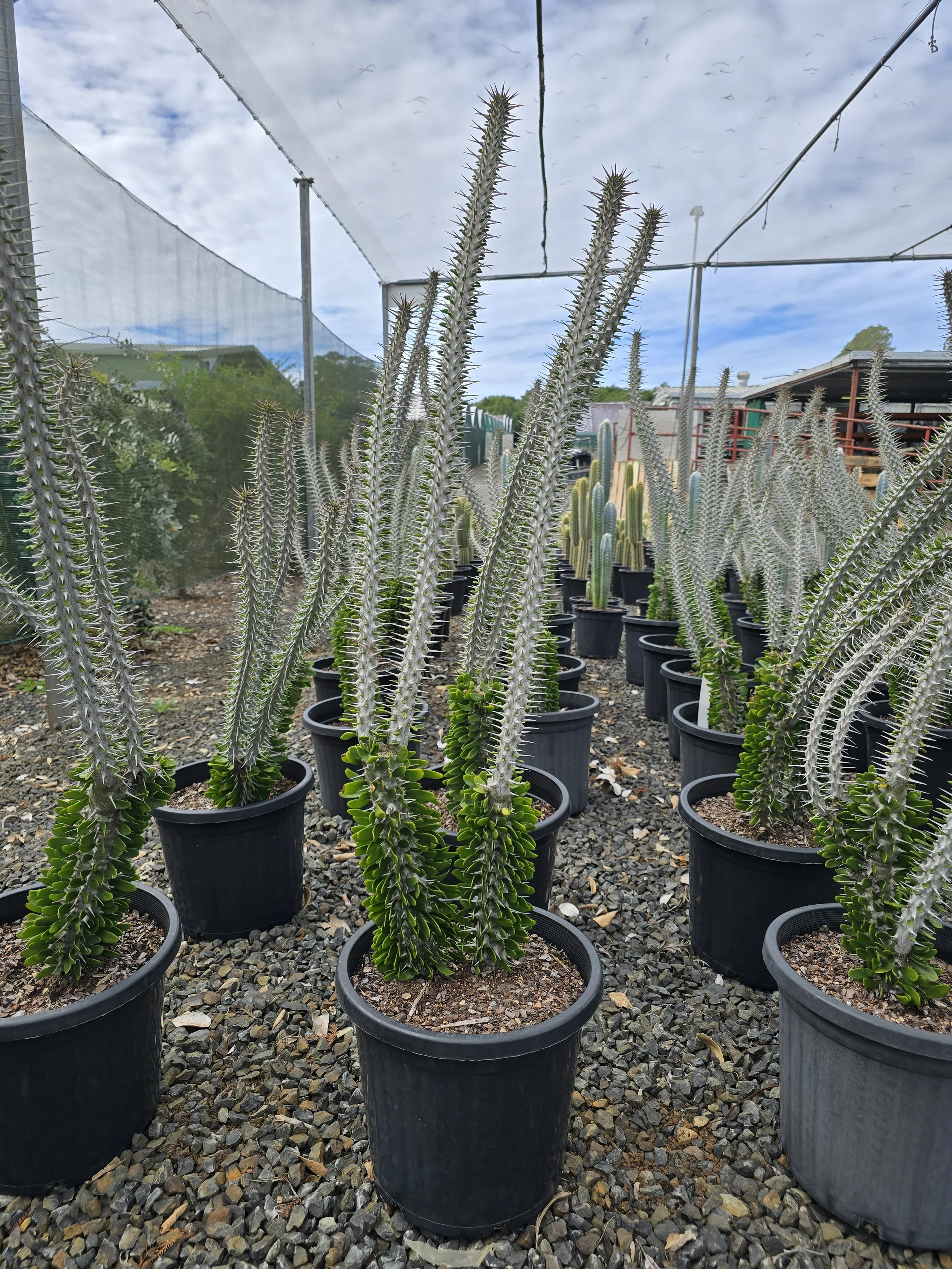 Image 1 of 1
Image 1 of 1


Alluaudia Procera 300mm
🌵 Alluaudia procera
Common Name: Madagascar Ocotillo, African Ocotillo, Madagascar Thorn Tree
Family: Didiereaceae
Origin: Endemic to southern Madagascar, where it grows in arid, spiny forests
📏 Physical Description
Growth Habit:
A deciduous, upright succulent shrub or small tree that can grow up to 15 meters (50 feet) tall in the wild, but usually reaches 2–5 meters (6–16 feet) in cultivation.
Has a distinctive, vertical branching pattern, often resembling a leafy cactus or ocotillo, though it is not closely related.Stems:
Tall, narrow, gray-green cylindrical stems lined with evenly spaced stout spines (1–2 cm long).
The stems are photosynthetic, helping the plant survive dry periods when it drops its leaves.Leaves:
Small, rounded, bright green leaves grow in pairs along the stems between the spines.
Deciduous in dry conditions, the plant sheds leaves to conserve moisture and survives using stem photosynthesis.
🌸 Flowers
Appearance:
Tiny, inconspicuous greenish-yellow to white flowers typically appear at the branch tips.
Flowers are usually produced on mature plants, especially in warm, bright conditions.Pollination:
In its native range, it is pollinated by insects and possibly lemurs; rarely flowers indoors or in pots.
🌱 Care and Cultivation
Light:
Requires full sun to thrive—ideal for hot, sunny spots.
Indoors, place near the brightest window, preferably with several hours of direct sunlight.Watering:
Water deeply but infrequently. Allow soil to dry completely between waterings.
In winter or dry dormancy, water very sparingly.Soil:
Needs excellent drainage. Use a gritty cactus/succulent mix with added sand or pumice.Temperature:
Thrives in warm climates.
Ideal range: 21–30°C (70–86°F)
Frost-sensitive: protect from temperatures below 5°C (41°F).Humidity:
Prefers dry air; thrives in arid or semi-arid environments.Feeding:
Fertilize sparingly—once per month in spring/summer with a cactus fertilizer.Pruning:
Minimal pruning required. Can be lightly shaped or cut back to control height or promote branching.Propagation:
Grown from cuttings or seeds, though cuttings can take time to root. Use gloves—spines are sharp!
✅ Quick Care Summary
RequirementDetailsLightFull sun (indoors or outdoors)WaterInfrequent; allow soil to dry completelySoilGritty, well-draining cactus mixTemperature21–30°C; protect from frostHumidityLow; prefers dry airGrowth HabitUpright, columnar, tree-like succulentPropagationCuttings or seeds
✅ Perfect For:
Xeriscapes and arid gardens
Architectural containers and patio displays
Modern interiors with lots of sunlight
Collectors of rare or Madagascar-native plants
🌵 Alluaudia procera
Common Name: Madagascar Ocotillo, African Ocotillo, Madagascar Thorn Tree
Family: Didiereaceae
Origin: Endemic to southern Madagascar, where it grows in arid, spiny forests
📏 Physical Description
Growth Habit:
A deciduous, upright succulent shrub or small tree that can grow up to 15 meters (50 feet) tall in the wild, but usually reaches 2–5 meters (6–16 feet) in cultivation.
Has a distinctive, vertical branching pattern, often resembling a leafy cactus or ocotillo, though it is not closely related.Stems:
Tall, narrow, gray-green cylindrical stems lined with evenly spaced stout spines (1–2 cm long).
The stems are photosynthetic, helping the plant survive dry periods when it drops its leaves.Leaves:
Small, rounded, bright green leaves grow in pairs along the stems between the spines.
Deciduous in dry conditions, the plant sheds leaves to conserve moisture and survives using stem photosynthesis.
🌸 Flowers
Appearance:
Tiny, inconspicuous greenish-yellow to white flowers typically appear at the branch tips.
Flowers are usually produced on mature plants, especially in warm, bright conditions.Pollination:
In its native range, it is pollinated by insects and possibly lemurs; rarely flowers indoors or in pots.
🌱 Care and Cultivation
Light:
Requires full sun to thrive—ideal for hot, sunny spots.
Indoors, place near the brightest window, preferably with several hours of direct sunlight.Watering:
Water deeply but infrequently. Allow soil to dry completely between waterings.
In winter or dry dormancy, water very sparingly.Soil:
Needs excellent drainage. Use a gritty cactus/succulent mix with added sand or pumice.Temperature:
Thrives in warm climates.
Ideal range: 21–30°C (70–86°F)
Frost-sensitive: protect from temperatures below 5°C (41°F).Humidity:
Prefers dry air; thrives in arid or semi-arid environments.Feeding:
Fertilize sparingly—once per month in spring/summer with a cactus fertilizer.Pruning:
Minimal pruning required. Can be lightly shaped or cut back to control height or promote branching.Propagation:
Grown from cuttings or seeds, though cuttings can take time to root. Use gloves—spines are sharp!
✅ Quick Care Summary
RequirementDetailsLightFull sun (indoors or outdoors)WaterInfrequent; allow soil to dry completelySoilGritty, well-draining cactus mixTemperature21–30°C; protect from frostHumidityLow; prefers dry airGrowth HabitUpright, columnar, tree-like succulentPropagationCuttings or seeds
✅ Perfect For:
Xeriscapes and arid gardens
Architectural containers and patio displays
Modern interiors with lots of sunlight
Collectors of rare or Madagascar-native plants